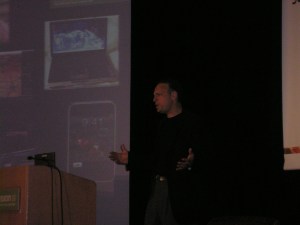 Sixty start-ups gathered today to talk at the Emerging Companies Summit about how they’re using graphics technologies in their businesses. The summit was one of the many sub-conferences at the Nvision 08 Visual Computing conference in San Jose.
Sixty start-ups gathered today to talk at the Emerging Companies Summit about how they’re using graphics technologies in their businesses. The summit was one of the many sub-conferences at the Nvision 08 Visual Computing conference in San Jose.
Jeff Herbst, (left) vice president of business development at Nvidia (sponsor of Nvision and the summit), said the company had many more applicants for the 60 presentation slots than it could accommodate. Those chosen came from 16 different countries.
None of those companies is creating a new graphics chip. The industry has moved on to funding start-ups that take advantage of ubiquitous graphics processors on computers. David Kirk, chief scientist of Nvidia, said many new companies are moving into the “first cousins” of graphics processing, such as image processing, computational photography, video editing and other things that take a lot of parallel calculations.
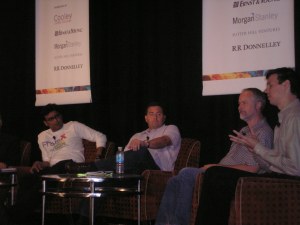 Kirk (middle right) made the point that there is a lot of graphics horsepower out there in the base of computers in homes and businesses. In fact, DisplaySearch calculated that the number of pixels in the world has grown to 8 trillion in 2008, up four-fold from 2004, largely because of the growth of all sorts of digital displays. It follows that making applications for these displays is going to be a good business.
Kirk (middle right) made the point that there is a lot of graphics horsepower out there in the base of computers in homes and businesses. In fact, DisplaySearch calculated that the number of pixels in the world has grown to 8 trillion in 2008, up four-fold from 2004, largely because of the growth of all sorts of digital displays. It follows that making applications for these displays is going to be a good business.
AI Weekly
The must-read newsletter for AI and Big Data industry written by Khari Johnson, Kyle Wiggers, and Seth Colaner.
Included with VentureBeat Insider and VentureBeat VIP memberships.
Start-ups should also consider how the technology will improve, thanks to Moore’s Law and design improvements. Computer vision might be possible with about 10 times more memory per chip and 100 times more processing power. Kirk said that might require a rack of servers full of graphics chips now, but the day isn’t that far away when a single chip could handle the computer-vision calculations.
Among the start-ups presenting today were gaming companies such as Nurien, a Seoul, South Korea-based 3-D social networking start-up which was highlighted in Nvidia CEO Jen-Hsun Huang’s keynote speech on Monday. It is a kind of Second Life (or IMVU, more accurately) on steroids with highly realistic Unreal Engine graphics. The game avatars, or characters, have as many as 150 simulated bones in their bodies, said Taehoon Kim, CEO of Nurien.
The three-year-old company raised $15 million in a first round in November 2007. Kim said he expects to raise another round after launching in September in China and South Korea. He expects to launch in the U.S. in May 2009. It will compete with Lively by Google and IMVU. Kim believes his 3-D characters will be more realistic and he expects to create a variety of casual games where players can use their avatars. The game will be free to play but players will buy items such as clothes or furniture for their apartments. Its closest competitor is Blue Mars, which is being developed by Hawaii’s Avatar Reality.
Asked about the focus on visual computing, Kim said he sensed more excitement because graphics is evolving much faster and the platform lets start-ups reach mass market consumers more quickly than they could before.
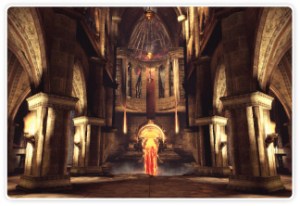 Sebastien Deguy, CEO of Allegorithmic, talked about his company, a French middleware start-up which uses math to compress the size of art in games as much as 98 percent. Deguy said this technology, dubbed Substance procedural textures 2.0, takes past compression techniques and makes them better.
Sebastien Deguy, CEO of Allegorithmic, talked about his company, a French middleware start-up which uses math to compress the size of art in games as much as 98 percent. Deguy said this technology, dubbed Substance procedural textures 2.0, takes past compression techniques and makes them better.
That enables faster display and more complexity of artistic scenes in video games and virtual worlds, Deguy said. An uncompressed texture from a game might require 270 megabytes of storage, but compression can take it down to 300,000 kilobytes. This technology enables companies to create realistic games that are light enough to run on simpler computers, run on handhelds, or be played on web sites without downloads. The textures can be changed based on the need: a game can display a gory scene with or without blood, based on the rating or local custom of where the game is sold, Deguy said. The company has game clients such as NCSoft and The9. It has 25 employees and was founded in 2003.
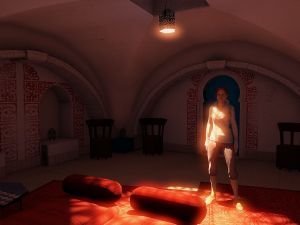 Like Allegorithmics, Geomerics provides middleware that could create much more realistic lighting and shadows in video games. The company has developed techniques such as “global illumination,” which makes games look as if there is a virtual sun shining in the world, casting accurate lighting and shadows. The company was founded in 2005 by former Cambridge University researchers in England.
Like Allegorithmics, Geomerics provides middleware that could create much more realistic lighting and shadows in video games. The company has developed techniques such as “global illumination,” which makes games look as if there is a virtual sun shining in the world, casting accurate lighting and shadows. The company was founded in 2005 by former Cambridge University researchers in England.
It has raised about 2.5 million pounds in a couple of rounds, said Chris Doran, chief operating officer. By licensing the company’s technology, game makers could more easily implement lighting effects in their games. Geomerics has 15 employees.
 Also participating were NaturalMotion and Pixelux Entertainment, whose technologies are used in the upcoming LucasArts video game “Star Wars: The Force Unleashed.”
Also participating were NaturalMotion and Pixelux Entertainment, whose technologies are used in the upcoming LucasArts video game “Star Wars: The Force Unleashed.”
NaturalMotion, based in Oxford, England, has created an animation technology dubbed Euphoria. It allows for the accurate simulation of human bodies. It embues animated bodies with accurate movement as well as artificial intelligence. In the upcoming “Backbreaker” football game, NaturalMotion says its technology enables unique tackles of football players in every play. The technology was also feature in Grand Theft Auto IV, where it let wounded characters to move in a realistic fashion.
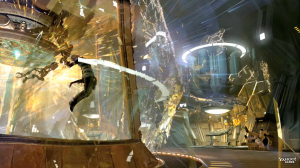 Pixelux Entertainment, meanwhile, embues the environment with realistic physics. In the Star Wars game, for instance, the Pixelux “digital molecular matter” technology enables trees to sway realistically in the wind or wood to break upon being struck.
Pixelux Entertainment, meanwhile, embues the environment with realistic physics. In the Star Wars game, for instance, the Pixelux “digital molecular matter” technology enables trees to sway realistically in the wind or wood to break upon being struck.
A good thing about the middleware companies is that they don’t require as much investment as hardware or chip start-ups. But they typically license their technologies to a small group of players and it remains to be seen whether the markets are big enough to justify venture investments.
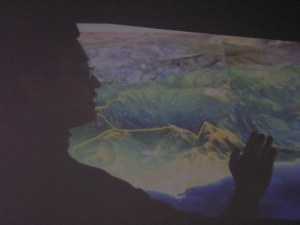 Jeff Han, founder and chief scientist of Perceptive Pixels, stole the show again as he did at the keynote speech as he showed off his multi-touch display. The New York company spun out of New York University in 2006 to focus on creating a touch user-interface for computers. Much like Microsoft’s Surface computer tables and Apple’s multi-touch iPhone displays, Han’s man-machine interface (with 60 inch and 100 inch screens) is much more intuitive and it allows multiple people to collaborate on the same machine. Every pixel on the display is a pressure-sensitive sensing element. It’s something to behold, like the scene where Tom Cruise moves images on a screen around on a screen in the sci-fi film “Minority Report.”
Jeff Han, founder and chief scientist of Perceptive Pixels, stole the show again as he did at the keynote speech as he showed off his multi-touch display. The New York company spun out of New York University in 2006 to focus on creating a touch user-interface for computers. Much like Microsoft’s Surface computer tables and Apple’s multi-touch iPhone displays, Han’s man-machine interface (with 60 inch and 100 inch screens) is much more intuitive and it allows multiple people to collaborate on the same machine. Every pixel on the display is a pressure-sensitive sensing element. It’s something to behold, like the scene where Tom Cruise moves images on a screen around on a screen in the sci-fi film “Minority Report.”
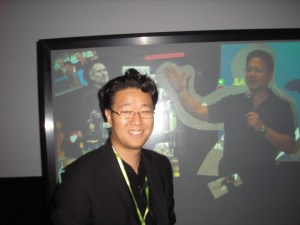 Han said a number of government agencies are already using his displays, which cost around $60,000 to $200,000 now. It started shipping in January 2007.
Han said a number of government agencies are already using his displays, which cost around $60,000 to $200,000 now. It started shipping in January 2007.
Han can’t identify which agencies are using it, but he hinted that they have three letters. Han’s focus is on the software, but he had to develop the displays as well because no one else made such screens. Han said the self-funded company is considering raising money. It has 10 employees.
“The market is ready for this now,” Han said. “There is so much untapped graphics processing power that is available in these machines.”
VentureBeat's mission is to be a digital town square for technical decision-makers to gain knowledge about transformative enterprise technology and transact. Learn More